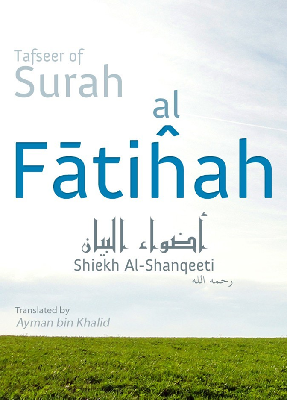In the Name of Allah, the Most Gracious, the Most Merciful.
Muhammad Al-Ameen Bin Muhammad Al-Mukhtaar Bin 'Abdil-Qādir Al-Jaknee Ash-Shanqītī was a scholar from the country of Mauritania. He was born in the year 1907 (or 1897) in a region called “Shanqeet” also known as the Chinguetti Department which is the eastern part of the state of Mauritania, which lies on the (eastern) coast of the Atlantic Ocean, south of Morocco and Algeria and north of Senegal.; hence, his title “Shanqeeti”.
Source of knowledge:
He gained most of his knowledge from his family since he was born into a very educated household. His lineage traces back to Ya'qūb Bin Jākin, the forefather of the large tribe, known as the Jaknees. At the tender age of ten, he memorized the Qur`ān with his uncle, Abdullah Bin Muhammad al-Mukhtār Bin Ibrahīm Bin Ahmad Nooh al-Jaknee. He mastered tajweed and the art of writing the Uthmāni Mushaf with his cousin, Muhammad Bin Ahmad Bin Muhammad al-Mukhtaar. He studied the basics of Arabic grammar, the Prophet Sallallahu `Alayhi Wasallam’s life history and the history of Arabian decent with his aunt.
As for the remaining fields of knowledge, such as fiqh, tafsīr, hadīth, Arabic grammar, usool al-fiqh and poetry, he studied with some of the scholars who were present at his time such as: Shaykh Muhammad Bin Sālih, Shaykh Ahmad al-Afram Bin Muhammad al-Mukhtār, Shaykh Ahmad Bin 'Umar, Shaykh Ahmad Bin Mood, Shaykh Muhammad an-Nimah Bin Zaydān and Shaykh Ahmad Fāl Bin Aaduh.
Achievements and Works in Life:
After his studies, he went on to teach and play the role of a judge in family jurisdiction. His rulings were heavily enforced, even by the rulers of his time. In the year 1947, he travelled to Saudi Arabia where he performed his Hajj. After completing his Hajj, he went to teach in the blessed Mosque of the Prophet (Sallallahu Alayhi Wasallam), Masjid An-Nabawi. The people were heavily influenced by his teaching style so they begged him to stay and continue his teachings in Makkah/Madina.
He was a great Mufassir (exegetist) and is predominantly known for his famous work, Adwaa-ul-Bayaan fee Tafseer-il-Qur'an bil-Qur'an. This is his Tafsīr in which his extraordinary eloquence and precision of Arabic grammar becomes evident. His knowledge of the Qur’an was so strong and vast, that should anyone mention to him an āyah of the Qur’an, he would immediately respond with the āyah before and after it. He authored his entire Tafsīr in this manner. This is the element that drew everyone towards his lessons.
Some of his students are widely known such as: Shaykh 'Abdul-'Azīz Bin Bāz, Shaykh Bakr Bin 'Abdullah Abu Zayd and Shaykh 'Atiyyah Muhammad Sālim, who completed the writing of Shaykh Shanqeeti’s tafseer, “Adwaa al-Bayān”, after the Shaykh's death.
In the year 1951, he was asked to teach in the institutes and colleges of Riyādh. After some time, he decided to move back to Madina to teach in the Islamic University of Madina. This is where he taught the founder of the Salafi sect known as the “Madkhaliyyah”, Rabī Al-Madkhali.
Outstanding Characteristics:
He had inculcated some amazing characteristics in his life. People claimed him to be a scholar who practiced what he preached and he never permitted anyone to backbite in his gatherings.
He was most noble and apathetic to what the life of this world had to offer. He was always truthful in speech, and most sincere; always prepared to change his point of view if presented with evidence.
He sought importance in seeking knowledge, and all fields of knowledge were just a means, as for the Qur’an, it was his ultimate goal.
Books:
Shaykh Shanqeeti has authored many books throughout his lifetime. Amongst them, a few famous ones are:
- Adwaa-ul-Bayān fee Tafseer-il-Qur'an bil-Qur'an [This is his tremendous voluminous work on Tafseer of the Qu’raan]
- Al-Mudhakkirah fee Usool-il-Fiqh [A small treatise on the Principles of Fiqh]
- Adab Al-Bahth wal-Munādhara [Etiquettes for Researching]
- Alfiyyah fil-Mantiq Daf'u Īhām Al-Idhtirāb 'an Āyāt-il-Kitāb
- Man'u Jawāz Al-Majāz
- Mandhūmah fil-Farā'idh [A Book on the Laws of Inheritance]
- Furū' Mālik – a poetic text
- Sharh 'alā Marāqee As-Sa'ūd – a dictation he made to his students
- Sharh 'alā As-Sullam – a dictation he made to his students
- Ansāb-ul-'Arab – a poetic text
- Manāhij wa Dirāsāt li-Āyāt-il-Asmā was-Sifāt – a transcribed lecture he gave in the Islaamic University of Madinah in 1962 (on the 13th of Ramadān, 1382 A.H).
School of thought:
Some people say he adhered to the Maliki Mazhab whereas many others claim him to be a Salafi.
Death:
The Shaykh passed away in the year 1973/1972 on his return from his Hajj in Makkah. He was buried in Jannat Al-Muallā. His Janaazah prayer was held in Masjid Al-Haram after the Zuhr prayer on the same day
Taken From: http://www.askimam.org/public/question_detail/28148


